Check out my custom vibration dampener
10+ Best Tennis Ball Hoppers & Baskets
Expert Guide & Reviews
We hope you love this article. Just so you know, TennisCompanion may collect a small share of sales from the links on this page to help keep this site running. Learn more.
A tennis ball hopper or basket is a practical piece of equipment for storing, picking up, and conveniently bringing tennis balls to the court.
Whether you use one to speed up ball collection, practice your serve, or feed balls to a friend or student, it’s a relatively inexpensive investment that will last for years if you take reasonable care of it.
Although buying a ball hopper is relatively straightforward, it’s helpful to become familiar with the various options available to avoid making a poor choice and ensure the best purchase the first time around.
As part of this guide, I’ll discuss features worth considering, present other pickup options you may not have stumbled on, share tips for buying balls for your hopper, and review my picks for the best.
| Model | Type |
| MasterPro Ball Hopper – 72 | Hopper / Basket |
| Wilson Ball Hopper – 75 | Hopper / Basket |
| Tourna Ballport Delux Wheels – 80 | Hopper / Basket |
| Gamma Ball Hopper Hi-Rise – 75 | Hopper / Basket |
| Gamma Ball Hopper Hi-Rise Gold – 75 | Hopper / Basket |
| Kollectaball K-Hopper – 60 | Roller |
| Tourna Tenn-Tube – 20 | Tube |
| Gamma Ball Tube – 18 | Tube |
| Tomohoppper Mower – 90 | Mower |
| OnCourt OffCourt Multimower – 300 | Mower |
| Pop-It – 1 | Single Ball Pickup |
Article Contents
Click below to jump to a section
Tap below to jump to a section
Why Buy a Hopper?
Features to Consider
Other Pickup Options
Balls for Your Hopper
10 Best Ball Hoppers
Wrapping Up
New to TennisCompanion?
Create a free account and explore my latest videos below
Why Buy a Hopper or a Basket?
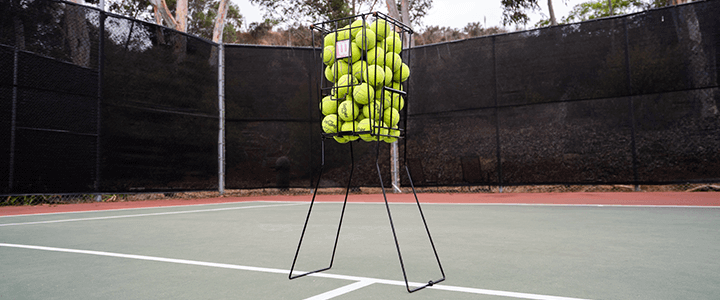
A ball hopper is an excellent investment if you’re committed to improving your game or helping someone else develop theirs. Here are a few of the most common reasons players buy them.
Faster & Easier Ball Collection

The number one reason for buying a ball hopper or basket is to speed up the ball collection process. If you’ve ever picked up more than a handful of tennis balls one by one, then you know what I mean.
Bringing more than a few balls for practice is an efficient way to maximize your time on the court, but the more balls you bring, the more tedious it is to pick them up.
For that reason, a tennis ball hopper is one of the most practical and valuable pieces of court equipment for players of all ages and levels.
If you’re lucky enough to own a tennis ball machine, a tennis ball hopper or basket is necessary. Ball machines often have high ball capacities to help players maximize their repetitions, so investing in one will save you time and energy.
Transporting Tennis Balls

It’s common for players to pick up a ball hopper to transport a large number of tennis balls to and from the court, rather than stashing them in their racquet bag or bringing an entirely separate bag.
If this is you, it’s worth looking for a basket with a lid that can be closed during transportation to prevent the balls from spilling.
Feeding Balls to a Friend or Student
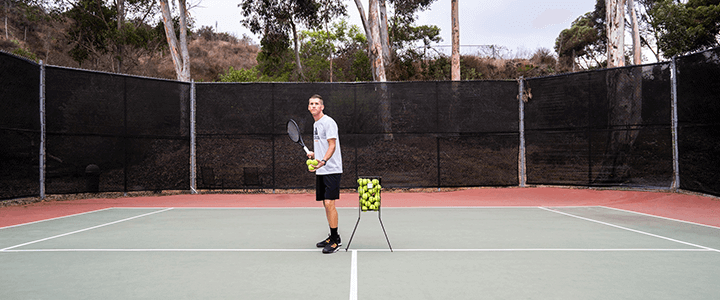
Another excellent reason to purchase a ball hopper is to practice with a friend or student, especially if it’s one of your children.
Feeding several balls to the same location to practice the same shot is an excellent way to develop a player’s skill.
If you’re buying a ball hopper for this purpose, you’ll likely want to purchase one with handles that double as legs by folding underneath the basket when you’re ready to feed.
Practicing Your Serve

The serve is one of the most critical shots to learn and one of the few that a player can practice independently. For that reason, I always encourage players to practice it often, and a ball hopper is one of the best accessories for the job.
Although it’s possible to bring a handful of balls to the court to practice your serve, it’s incredibly more efficient to carry 50 so you can get adequate repetitions under your belt.
For maximum convenience, you’ll want to find a ball hopper with handles that convert to legs when folded so that you can grab balls without having to bend down to pick them up.
Features to Consider
Surprisingly, there are more than a few features that you can consider when purchasing a ball hopper or basket. Here are some of the most important to keep in mind.
Size or Capacity

Most ball hoppers have a capacity of 40-140 tennis balls, and the larger they are, the more balls they carry. For most players, a ball hopper with a capacity of 50-75 balls is more than sufficient.
There are two factors to consider here. First, if you want to take full advantage of a larger basket, you’ll have to buy more tennis balls, which can get expensive. Second, the more balls you carry, the more difficult it will be to transport the basket, and the more challenging it will be to use for picking up balls as it fills up.
Size is also important to consider if children will use the hopper to help since they’ll require a smaller hopper.
Weight

Hand in hand with size, the weight of a ball hopper is worth noting when you make a purchase. Although the weight of an empty basket might not seem like much, once you add tennis balls, it can add up.
An average tennis ball weighs around 55-60 grams. With that in mind, here’s roughly how much weight balls will add on the low end:
| 25 | 3 lbs / 1.4 kg |
| 50 | 6 lbs / 2.8 kg |
| 75 | 9 lbs / 4.1 kg |
| 100 | 12 lbs / 5.5 kg |
| 125 | 15 lbs / 6.9 kg |
| 150 | 18 lbs / 8.3 kg |
Again, these aren’t massive numbers, but the convenience factor does begin to drop slightly the larger the basket gets, so it’s worth keeping in mind. Once again, you’ll want a smaller basket to keep the weight lower if you’re dealing with kids.
The materials can also contribute to a hopper’s weight, so if you’re looking for the lightest, one with plastic construction might be ideal.
Height

When you pick up balls, you want the ball hopper’s height to be tall enough so that you’re not bending or crouching when you press it down on top of the balls to pick them up.
Companies making ball hoppers recognize this for the most part, but I have encountered a few unreasonably short baskets that make the cleanup process less convenient.
Someone six-foot-tall will want a basket that stands roughly 30 inches (give or take one or two inches) tall when picking up balls. Usually, if it’s taller, that’s less of a problem, but you don’t want it to be too short.
It’s also worth noting that a handful of hoppers, like the Gamma Ball Hopper Pro 90, offer adjustable handles.
Materials

Steel and plastic are the two most common materials used for ball hoppers. A steel hopper generally offers added durability, but it can increase its weight, so there may be a tradeoff.
Beyond the core materials, some baskets offer coatings to help protect them against the elements. If that’s a concern and you’re looking for a basket that will last longer, then it’s worth considering.
Construction

Various ball hoppers will offer varying degrees of construction for added durability. For example, some ball hoppers offer thicker steel and more robust welding to improve their durability.
A few companies have introduced a floating wire at the bottom of their baskets, making pressing down on balls to collect them dramatically easier, which is a handy feature if you’ve struggled to pick up balls with a standard hopper in the past.
Legs

Many ball hoppers offer handles that convert into legs by collapsing beneath the basket, which is handy for raising it off the ground when feeding or grabbing balls while serving.
For most players, finding a basket that offers this feature is a no-brainer. However, due to their design, these baskets tend to be a bit less durable.
With that in mind, some people and clubs may opt for ball hoppers that don’t have legs and only pick up balls, especially if they use larger carts for feeding balls.
Lid

If you’re using your ball hopper to transport your balls, finding one that offers a lid is useful. On several occasions, I’ve watched players accidentally tip over their basket outside the court and in the parking lot, and tracking down the balls is a pain.
A lid is a simple addition to a ball basket, saving you the frustration of picking up spilled balls.
Wheels

Finally, depending on the capacity of the ball hopper you purchase and who will be using it, wheels may be a welcome addition.
A handful of baskets offer wheels for easier transportation, which can be particularly useful if children are involved.
Other Tennis Ball Pickup Options
Ball hoppers and baskets are among the most popular options for picking up tennis balls, but a handful of others are worth considering.
Tubes
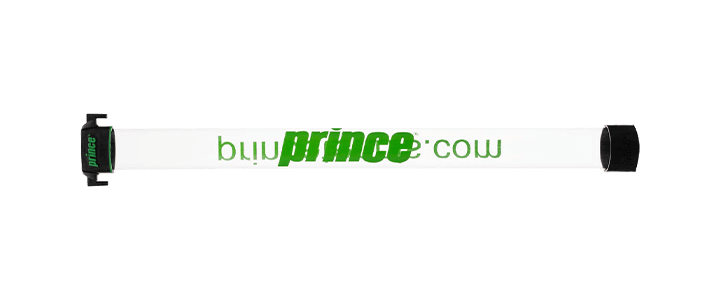
Another popular option for picking up tennis balls is tubes, which can pick up a single ball one at a time. They’re perfect for kids and can make ball pickup fun rather than arduous.
Tennis tubes come in various sizes and ball capacities, typically ranging from 15 to 21 balls. Some features to look out for include straps for carrying, rubber bands to prevent balls from falling out, and a small hook at the top end for hanging on a cart or fence.
Rollers

A modern take on ball pickup, companies like Kollectable have popped up with a new design that players roll over the balls as if they were mopping the floor to pick them up.
You’ll find they come in various sizes, with the main advantage being the speed at which you can pick up balls.
Most products in this category are designed exclusively for ball pickup, but you can find a handful of options that also double as hoppers or baskets for feeding.
Mowers
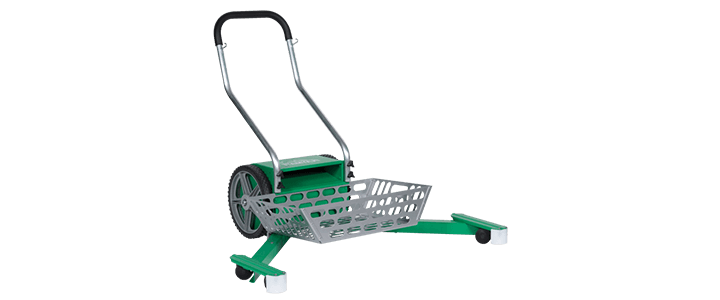
Mowers are the fastest way to pick up many balls with the least effort. A player pushes the mower forward, and large arms funnel the balls to the machine’s center, which forces them out of the top and into a basket.
Although their use skews toward tennis clubs, a few more portable options with collapsible components for transportation have entered the market.
Single Ball Pickup

On the opposite end of the spectrum from mowers is a product called Pop-It, which attaches to the end of a racquet’s handle.
Once attached, you can press the butt of your racquet’s handle down on top of a single ball to pick it up without bending down.
Although it might seem a bit gimmicky, it can help make ball pickup fun for kids, just like a ball tube. It’s also practical for anyone with back issues who has challenges bending over to pick up balls during play.
Robot or Electric

For years we’ve used machines to feed us tennis balls, now one company, Tennibot, is setting out to do the same with ball pick up.
Tennibot works much like a Roomba robot vacuum. You tell it where to clean, and it scours the court, picking up balls on its own. The founders launched a Kickstarter campaign to help get the product off the ground, and now it’s available to order.
It’s about as extravagant as it gets for court equipment, but if you appreciate new tech, it may be a product worth considering.
Tennis Balls for Your Hopper or Basket

If you’re purchasing a ball hopper, you’ll need to buy some tennis balls in bulk to fill the basket. One factor to consider when deciding which to buy is whether they’re pressurized or pressureless.
Pressurized
Most tennis players will be familiar with pressurized tennis balls. The cans for these balls, which usually come with three or four balls, contain nitrogen for pressure.
As a result, they offer exceptional bounce and are the type of balls used for virtually all competitions and, in many cases, lessons. However, their most significant drawback is that they lose pressure and require replacement after a short period – usually a few weeks max.
If you compete a lot, you may opt to regularly replace pressurized tennis balls so that you don’t have to transition back and forth from one ball to another, but this can get expensive.
Pressureless
Pressureless tennis balls are an excellent alternative to pressurized balls. Because they aren’t pressurized with nitrogen, manufacturers typically sell them in a mesh bag or bucket.
They’re a bit heavier and don’t have quite the same bounce as your standard pressurized balls, but they last considerably longer, and their bounce improves with use as the rubber softens.
In many cases, pressureless tennis balls are ideal for use with a hopper, especially if you only occasionally take your hopper to the court for practice.
For example, if you open ten cans of pressurized tennis balls and use them to practice once but don’t get a chance to practice with them for a few weeks, they’ll lose significant pressure and die.
However, under that exact scenario, pressureless tennis balls would be as good as new a few weeks later. Of course, once the felt wears and gets too dirty, you’ll still need to replace them. Still, you’ll get significantly more uses out of them over an extended period, perfect for practice.
The downside is that they play slightly differently than pressureless balls, so you’ll need to adjust the next time you hit the court with pressurized balls.
10+ Best Ball Hoppers, Baskets, Tubes, and Mowers
There are several options for collecting or picking up tennis balls, so I’ve pulled together my ten favorites.
As far as options go, my favorite is your standard hopper, which is the most versatile for the price, so I’ve listed those first.
Of course, everyone’s needs vary, so hopefully, you find something that works for your specific needs.
Wilson Ball Hopper – 75 balls

My favorite ball hopper on the market is the Wilson 75 tennis ball hopper – it’s no-frills, yet it checks all the right boxes.
Its carrying capacity is more than sufficient, and it doubles as a hopper to collect balls. There are slots to lock the legs if you choose when standing, but I never feel the need to use them. It also has a sturdy lid that prevents accidental spills.
There’s a light protective coating that will help shield the metal, but don’t expect too much from it. Courts are abrasive, so it’ll wear whenever the basket handles or bottom rub against it or the handles hit the side. Some minor rust may develop over time, but that’s pretty much the case with every ball hopper I’ve used.
For the cost, I usually replace mine every 3-5 years.
MasterPro Ball Hopper – 72 balls

An excellent, more feature-rich alternative to the Wilson Ball Hopper is the Master Pro, which holds roughly the same amount of balls.
It offers virtually identical features to the Hi-Rise Gold but has a few minor differences. First, there’s only one bar at the bottom, referred to as EZ-Glide Bars, which moves to make picking up balls easier. Second, they provide a short chain to help secure the legs when the hopper stands upright, which is helpful.
Again, expect some rust over the basket’s lifetime. They take a beating, so it’s unreasonable to expect otherwise.
The MasterPro Ball Hopper comes in two additional sizes:
- MasterPro 100
- MasterPro 50
Tourna Ballport Delux with Wheels – 80 balls

Next up, the Ballport Delux from Tourna is another long-standing option worth checking out.
Two features that make it popular are the hopper’s plastic construction, which helps reduce weight while eliminating any rust in that part of the basket, and its wheels for transportation.
The bars at the bottom for collecting balls move and flex slightly to make pressing down on balls easier. Furthermore, the handles lock when the hopper stands upright for feeding balls or practicing your serve.
At the top, two sliding bars close the basket for transportation and keeping the balls in place. It’s not as secure as some other baskets, and they can sometimes be a bit finicky, but it does the trick.
Although the plastic is excellent for keeping weight down, it’s not the most durable. I’ve seen a player hit a forehand right through the side of one of these, which is a rare occurrence but worth noting. Like other baskets, you’ll find some rust develops over time on the handles as they come in contact with the court surface, but that’s pretty standard.
The Tourna ball hopper comes in black, red, and blue and in two additional models:
- Ballport 80
- Ballport Mini
Gamma Ball Hopper Hi-Rise – 75 Balls

The Gamma Hi-Rise is an excellent economical option, delivering essential features for efficient ball clean-up and storage.
For starters, the ball hopper can pick up and hold 75 balls, which is perfect for casual practice or coaching.
As far as ball pickup goes, the Gamma Hi-Rise features locking handles to prevent them from falling to the ground and is ideal for travel. The handles can swivel below the basket to raise it to waist height so you can easily grab the balls. The legs won’t lock, but I haven’t found that feature on other baskets to be useful, so it’s not something I’d be concerned about having for your basket.
To improve durability, Gamma uses carbon steel wire coated with its Diamond Clad weather-resisting coating to prevent rust, which it does well. The hopper also comes with plastic feet and corner bumpers to help reduce the likelihood of scrapping the court.
Lastly, you’ll find a wire lid that closes over the top of the basket to keep the balls contained and reduce the likelihood of spills.
Gamma Ball Hopper Hi-Rise Gold – 75 balls
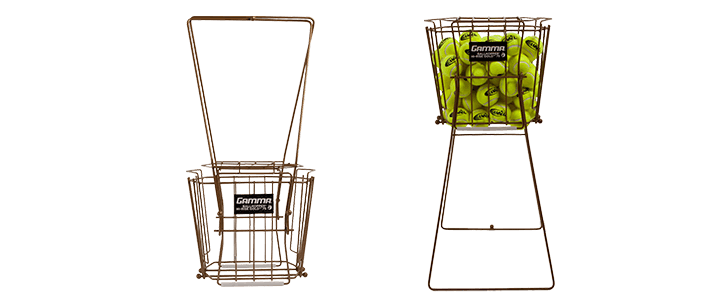
Another excellent ball hopper is the Gamma Hi-Rise Gold, which holds 75 balls like the Wilson ball hopper.
To help protect against rust and prolong the basket’s life, it has a polyester coating for added durability. Furthermore, you’ll also find the basket offers floating rods at the bottom, which move slightly to the side when pressing down to collect balls and make it easier.
Like other ball hoppers, it will develop rust over time due to the court’s abrasive surface and the arms or legs coming in contact with the side of the hopper, but it’s what I’d consider normal wear and tear.
This specific model only comes in one size, but Gamma offers a variety of other ball hoppers, including:
- Ball Hopper 90
- Ball Hopper Whopper 140
- Ball Hopper Hi-Rise 75
- Ball Hopper Hi-Rise 75 with wheels
- Ball Hopper Risette 50
Kollectaball K-Hopper – 60 balls

If you’re looking for a faster way to pick up tennis balls, the Kollectaball Hooper might be more suitable.
It’s an entirely different concept from your typical ball hopper but equally effective. Instead of pressing, you roll a cage of 60 flexible wires over the balls, which open to allow balls in, not out.
When rolling a Kollectaball Hopper, you can adjust the handle’s height if you prefer, and when turned upside down, they double as legs. Once again, you can change the legs for the desired feeding height.
Two arms swivel toward the wires, spreading them apart to empty or keeping them open to grab balls when feeding. Luckily, you can replace the individual wires with new ones if necessary.
It’s a great concept, but the biggest downside is the cost. In most cases, this hopper is roughly double the price of most standard hoppers. If you’re not interested in using it for feeding and only for pickup, there are three other models to check out:
- Kollectaball Max
- Kollectaball Strike
- Kollectaball K-Mini
Tourna Tenn-Tube – 20 Balls

The Tourna Tennis Tube is an excellent option for anyone looking for a simpler device for picking up tennis balls.
Press it over the top of a ball, and it will stay locked inside. When you’re ready to empty it, turn it upside down.
The tube holds up to 20 balls. It has a rubber band on the top that you can pull on or off to keep the balls secure during transportation. It also has handy hooks at the top for attaching it off the ground against a fence or on the edge of a ball cart.
It’s made of transparent plastic and comes in three colors: red, blue, and yellow. Tourna also offers a smaller kids’ tennis tube that is shorter in height, picks up stage 1, 2, and 3 balls, and holds up to 15 regular-sized balls.
Gamma Ball Tube – 18 Balls

An alternative to the Tourna Tennis Tube is the Gamma Ball Tube, which has virtually identical features.
The only difference is that the Gamma Ball Tube holds a maximum of 18 balls and comes with a carrying strap if that interests you.
It also comes in clear plastic or red.
Tomohoppper Mower – 90 balls

Ball mowers are the most efficient way to pick up large quantities of tennis balls. If you’re an instructor or have a court at home, it may be worth considering one to reduce pickup time for more efficient lessons or time on the court – especially private lessons.
The Tomohopper offers a unique design that works great for picking up balls. However, it also functions as a basket. After you’ve collected balls, you can raise the hopper to a sufficient height for feeding.
Perhaps one of the best features of the Tomohopper is how compact it collapses for travel to stick in a trunk.
The machine has a limited capacity for its size at only 90 balls, so you’ll need to consider that. Furthermore, it only works with standard yellow tennis balls. If you’re looking to use one for larger kids’ tennis balls, then the Tennis Multimower is ideal.
OnCourt OffCourt Multimower – 300

With a higher overall capacity of 300 balls and the mower’s ability to pick up a variety of different-size tennis balls, the Tennis Multimower is worth checking out and is one of the best on the market.
Like the Tomohopper, it’s incredibly efficient at picking up tennis balls. It has two baskets – one for collecting balls and another for feeding them.
It’s not as compact for transportation but easily collapses by removing the vertical handles, so if your car has enough space, it can work well on the go, too.
Pop-It – 1 Ball

Finally, the Pop-It ball pickup accessory is a useful tennis accessory for picking up individual balls while playing. It’s not intended for efficiently picking up many tennis balls. Instead, its design is perfect for picking up a single ball while playing rather than bending over.
It always stays on the racquet, so you may need to get used to that, particularly if you’re an adult. However, it might be a solution worth considering if you struggle with back pain or have difficulty bending over.
For kids, it’s a fun way to help the instructor or a parent pick up balls.
The Pop-It comes in two colors: black for adults and green for kids. Some players struggle to keep the accessory in place on their racquet, so you may need to build up your racquet’s handle with an extra overgrip to fit correctly.
Wrapping Up
Picking up balls is a tedious task, but if you’re taking lessons or practicing, it’s a necessary part of the process. To make pickup more efficient and transportation of balls easier, a ball hopper, basket, tube, roller, or mower are excellent options to consider.
Hopefully, this guide has helped provide some useful insight on what to look for when buying a ball hopper while also providing some worthy options to consider if you’re in the market.
If you have any questions about anything covered in this guide, drop a comment below, I’d love to hear from you.
Home > Gear > Equipment > Best Tennis Ball Hoppers & Baskets
Play Better Tennis
Improve your game alongside our community of tennis players
Why join?
Discussion Boards
Join the conversation with other members of the community.
5 Point Friday
Read our weekly recap of the 5 most interesting things we dig up in tennis.
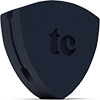


Leave a Reply
Want to join the discussion?Feel free to contribute!